Abstract
The alpha epimers of pyridine nucleotides are almost totally inactive as reductants in dehydrogenase reactions. In contrast, the R plasmid R67-specified dihydrofolate reductase (5,6,7,8-tetrahydrofolate: NADP+ oxidoreductase, EC 1.5.1.3) isolated from trimethoprim-resistant Escherichia coli utilized alpha-NADPH and alpha-NADH in addition to the "normal" beta-epimers. The enzymes from bacterial and mammalian sources used only beta-NADPH and beta-NADH. THe Km value for alpha-NADPH (16 microM) was 4-fold greater than that for beta-NADPH (4 microM), while the maximal velocity of the alpha-NADPH-catalyzed reaction was 70% of that seen with the beta-NADPH. beta-NADP+ and alpha-NADP+ were competitive inhibitors of the R67 enzyme. Pyridine nucleotide analogues such as deamino- and acetyl-NADPH were used readily by bacterial, plasmid, and mammalian enzymes, whereas thio-NADPH was used only by the plasmid enzyme. These data suggest that the enzyme from R plasmid R67 possesses a pyridine nucleotide binding site different from that of other dihydrofolate reductases and dehydrogenases.
Full text
PDF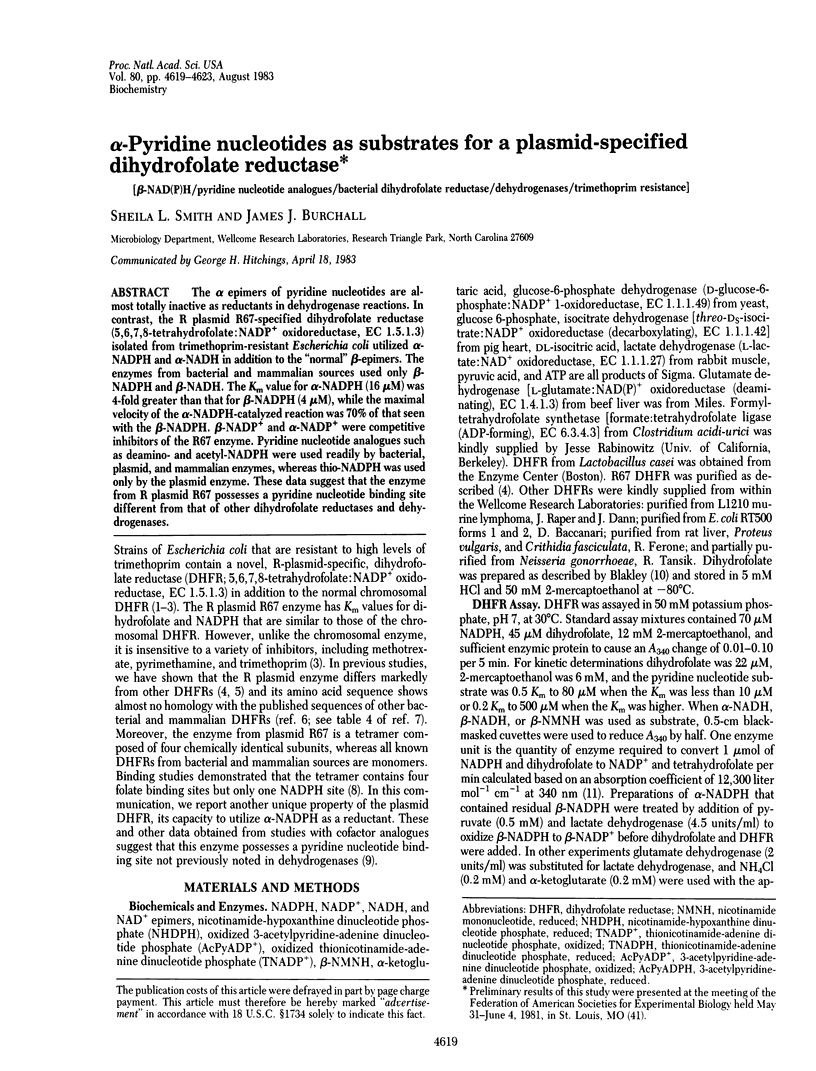
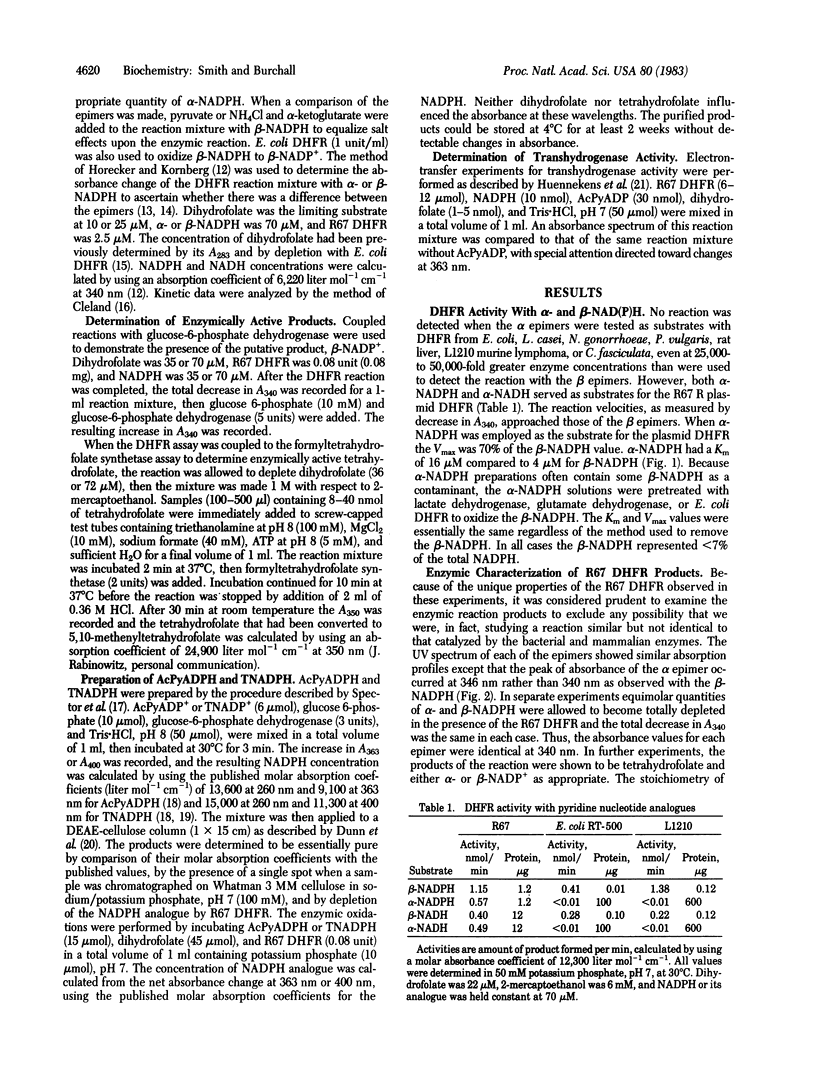
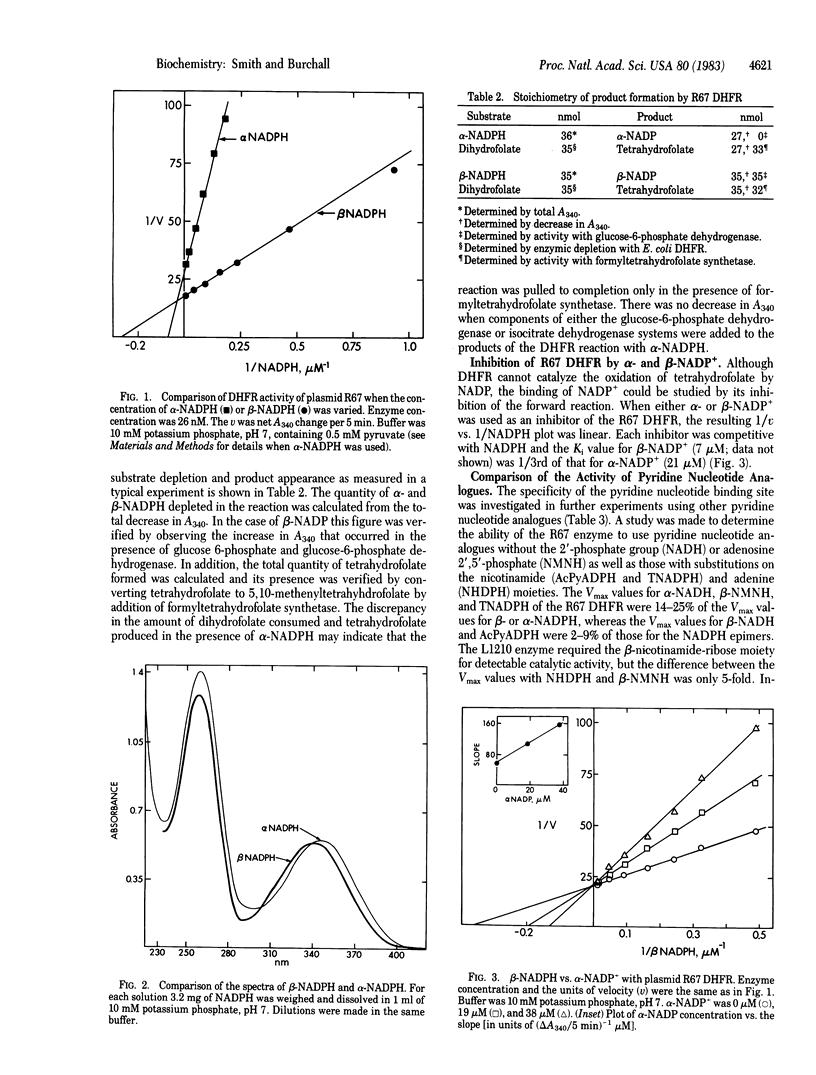
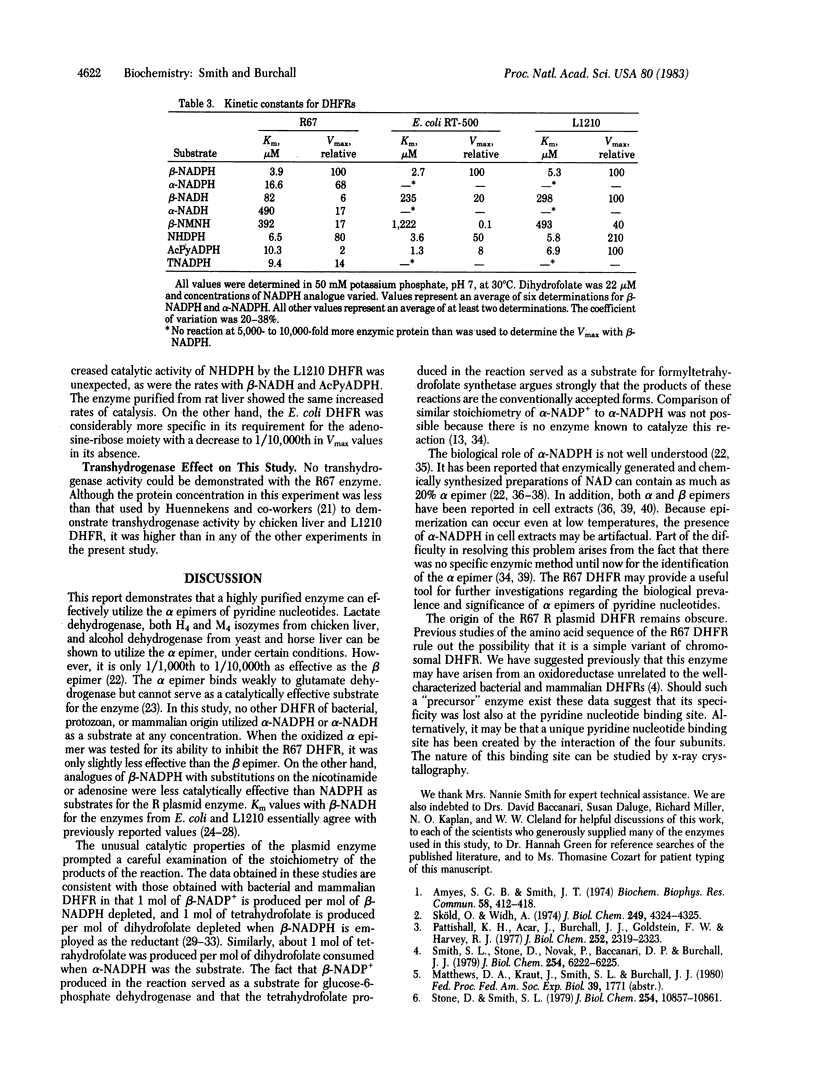
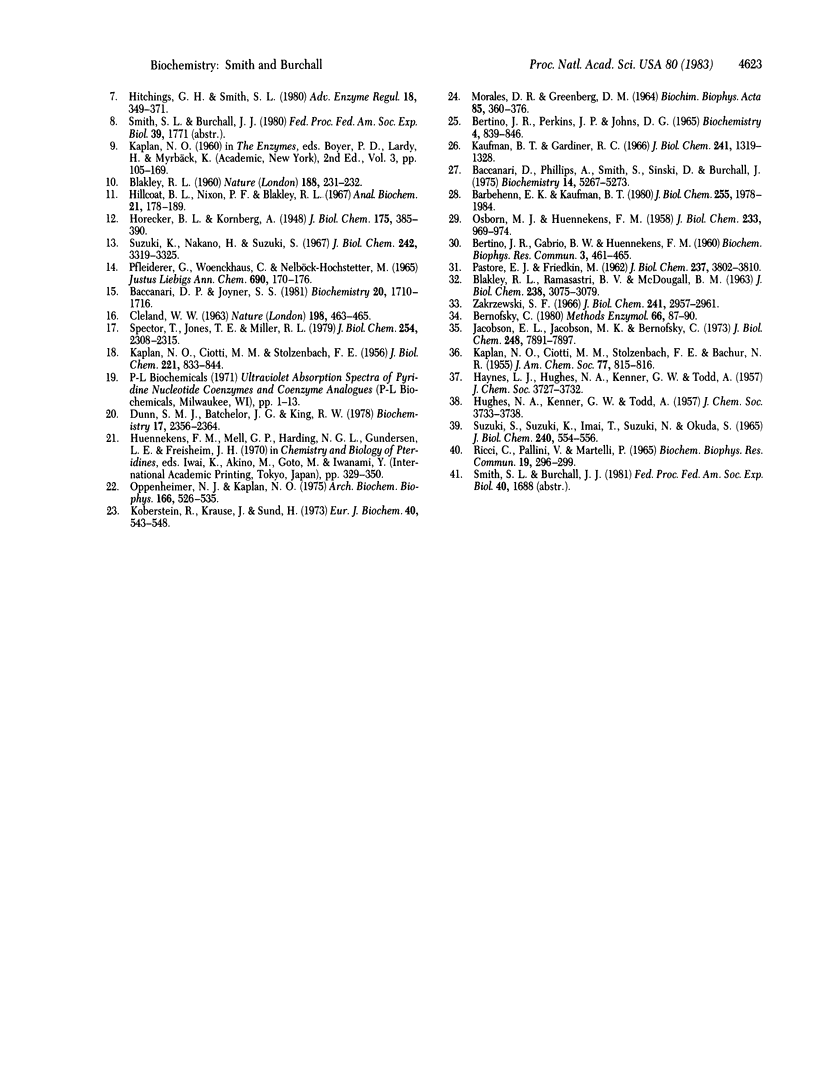
Selected References
These references are in PubMed. This may not be the complete list of references from this article.
- Amyes S. G., Smith J. T. R-factor trimethoprim resistance mechanism: an insusceptible target site. Biochem Biophys Res Commun. 1974 May 20;58(2):412–418. doi: 10.1016/0006-291x(74)90380-5. [DOI] [PubMed] [Google Scholar]
- BERTINO J. R., PERKINS J. P., JOHNS D. G. PURIFICATION AND PROPERTIES OF DIHYDROFOLATE REDUCTASE FROM EHRLICH ASCITES CARCINOMA CELLS. Biochemistry. 1965 May;4:839–846. doi: 10.1021/bi00881a007. [DOI] [PubMed] [Google Scholar]
- BLAKLEY R. L., RAMASASTRI B. V., MCDOUGALL B. M. THE BIOSYNTHESIS OF THYMIDYLIC ACID. V. HYDROGEN ISOTOPE STUDIES WITH DIHYDROFOLIC REDUCTASE AND THYMIDYLATE SYNTHETASE. J Biol Chem. 1963 Sep;238:3075–3079. [PubMed] [Google Scholar]
- Baccanari D. P., Joyner S. S. Dihydrofolate reductase hysteresis and its effect of inhibitor binding analyses. Biochemistry. 1981 Mar 31;20(7):1710–1716. doi: 10.1021/bi00510a002. [DOI] [PubMed] [Google Scholar]
- Baccanari D., Phillips A., Smith S., Sinski D., Burchall J. Purification and properties of Escherichia coli dihydrofolate reductase. Biochemistry. 1975 Dec 2;14(24):5267–5273. doi: 10.1021/bi00695a006. [DOI] [PubMed] [Google Scholar]
- Barbehenn E. K., Kaufman B. T. Alteration of the properties of chicken liver dihydrofolate reductase as a result of modification by tetrathionate. J Biol Chem. 1980 Mar 10;255(5):1978–1984. [PubMed] [Google Scholar]
- Bernofsky C. Preparation of alpha-NADP+. Methods Enzymol. 1980;66:87–90. doi: 10.1016/0076-6879(80)66442-8. [DOI] [PubMed] [Google Scholar]
- CIOTTI M. M., KAPLAN N. O., STOLZENBACH F. E. Reaction of pyridine nucleotide analogues with dehydrogenases. J Biol Chem. 1956 Aug;221(2):833–844. [PubMed] [Google Scholar]
- CLELAND W. W. Computer programmes for processing enzyme kinetic data. Nature. 1963 May 4;198:463–465. doi: 10.1038/198463a0. [DOI] [PubMed] [Google Scholar]
- Dunn S. M., Batchelor J. G., King R. W. Kinetics of ligand binding to dihydrofolate reductase: binary complex formation with NADPH and coenzyme analogues. Biochemistry. 1978 Jun 13;17(12):2356–2364. doi: 10.1021/bi00605a016. [DOI] [PubMed] [Google Scholar]
- Hillcoat B. L., Nixon P. F., Blakley R. L. Effect of substrate decomposition on the spectrophotometric assay of dihydrofolate reductase. Anal Biochem. 1967 Nov;21(2):178–189. doi: 10.1016/0003-2697(67)90179-0. [DOI] [PubMed] [Google Scholar]
- Hitchings G. H., Smith S. L. Dihydrofolate reductases as targets for inhibitors. Adv Enzyme Regul. 1980;18:349–371. doi: 10.1016/0065-2571(80)90025-4. [DOI] [PubMed] [Google Scholar]
- Jacobson E. L., Jacobson M. K., Bernofsky C. Evidence against the natural occurrence of alpha-nicotinamide adenine dinucleotide in Azotobacter vinelandii. J Biol Chem. 1973 Nov 25;248(22):7891–7897. [PubMed] [Google Scholar]
- Kaufman B. T., Gardiner R. C. Studies on dihydrofolic reductase. I. Purification and properties of dihydrofolic reductase from chicken liver. J Biol Chem. 1966 Mar 25;241(6):1319–1328. [PubMed] [Google Scholar]
- Koberstein R., Krause J., Sund H. Studies of glutamate dehydrogenase. The interaction of glutamate dehydrogenase with alpha-NADH. Eur J Biochem. 1973 Dec 17;40(2):543–548. doi: 10.1111/j.1432-1033.1973.tb03225.x. [DOI] [PubMed] [Google Scholar]
- MORALES D. R., GREENBERG D. M. PURIFICATION AND PROPERTIES OF DIHYDROFOLATE REDUCTASE OF SHEEP LIVER. Biochim Biophys Acta. 1964 Jun 1;85:360–376. doi: 10.1016/0926-6569(64)90300-1. [DOI] [PubMed] [Google Scholar]
- OSBORN M. J., HUENNEKENS F. M. Enzymatic reduction of dihydrofolic acid. J Biol Chem. 1958 Oct;233(4):969–974. [PubMed] [Google Scholar]
- Oppenheimer N. J., Kaplan N. O. The alpha beta epimerization of reduced nicotinamide adenine dinucleotide. Arch Biochem Biophys. 1975 Feb;166(2):526–535. doi: 10.1016/0003-9861(75)90416-6. [DOI] [PubMed] [Google Scholar]
- PASTORE E. J., FRIEDKIN M. The enzymatic synthesis of thymidylate. II. Transfer of tritium from tetrahydrofolate to the methyl group of thymidylate. J Biol Chem. 1962 Dec;237:3802–3810. [PubMed] [Google Scholar]
- Pattishall K. H., Acar J., Burchall J. J., Goldstein F. W., Harvey R. J. Two distinct types of trimethoprim-resistant dihydrofolate reductase specified by R-plasmids of different compatibility groups. J Biol Chem. 1977 Apr 10;252(7):2319–2323. [PubMed] [Google Scholar]
- Pfleiderer G., Woenckhaus C., Nelböck-Hochstetter M. Die intramolekulare Wechselwirkung zwischen Heterocyclen in Coenzymen. II. Alpha-Nicotinamid-adenin-dinucleotid. Justus Liebigs Ann Chem. 1965 Dec;690:170–176. doi: 10.1002/jlac.19656900116. [DOI] [PubMed] [Google Scholar]
- RICCI C., PALLINI V., MARTELLI P. STEREOSPECIFICITY OF THE ENZYMIC NAD SYNTHESIS. Biochem Biophys Res Commun. 1965 Apr 23;19:296–299. doi: 10.1016/0006-291x(65)90457-2. [DOI] [PubMed] [Google Scholar]
- Sköld O., Widh A. A new dihydrofolate reductase with low trimethoprim sensitivity induced by an R factor mediating high resistance to trimethoprim. J Biol Chem. 1974 Jul 10;249(13):4324–4325. [PubMed] [Google Scholar]
- Smith S. L., Stone D., Novak P., Baccanari D. P., Burchall J. J. R plasmid dihydrofolate reductase with subunit structure. J Biol Chem. 1979 Jul 25;254(14):6222–6225. [PubMed] [Google Scholar]
- Spector T., Jones T. E., Miller R. L. Reaction mechanism and specificity of human GMP reductase. Substrates, inhibitors, activators, and inactivators. J Biol Chem. 1979 Apr 10;254(7):2308–2315. [PubMed] [Google Scholar]
- Stone D., Smith S. L. The amino acid sequence of the trimethoprim-resistant dihydrofolate reductase specified in Escherichia coli by R-plasmid R67. J Biol Chem. 1979 Nov 10;254(21):10857–10861. [PubMed] [Google Scholar]
- Suzuki K., Nakano H., Suzuki S. Natural occurrence and enzymatic synthesis of alpha-nicotinamide adenine dinucleotide phosphate. J Biol Chem. 1967 Jul 25;242(14):3319–3325. [PubMed] [Google Scholar]
- Zakrzewski S. F. Evidence for the chemical interaction between 2-mercaptoethanol and tetrahydrofolate. J Biol Chem. 1966 Jun 25;241(12):2957–2961. [PubMed] [Google Scholar]


